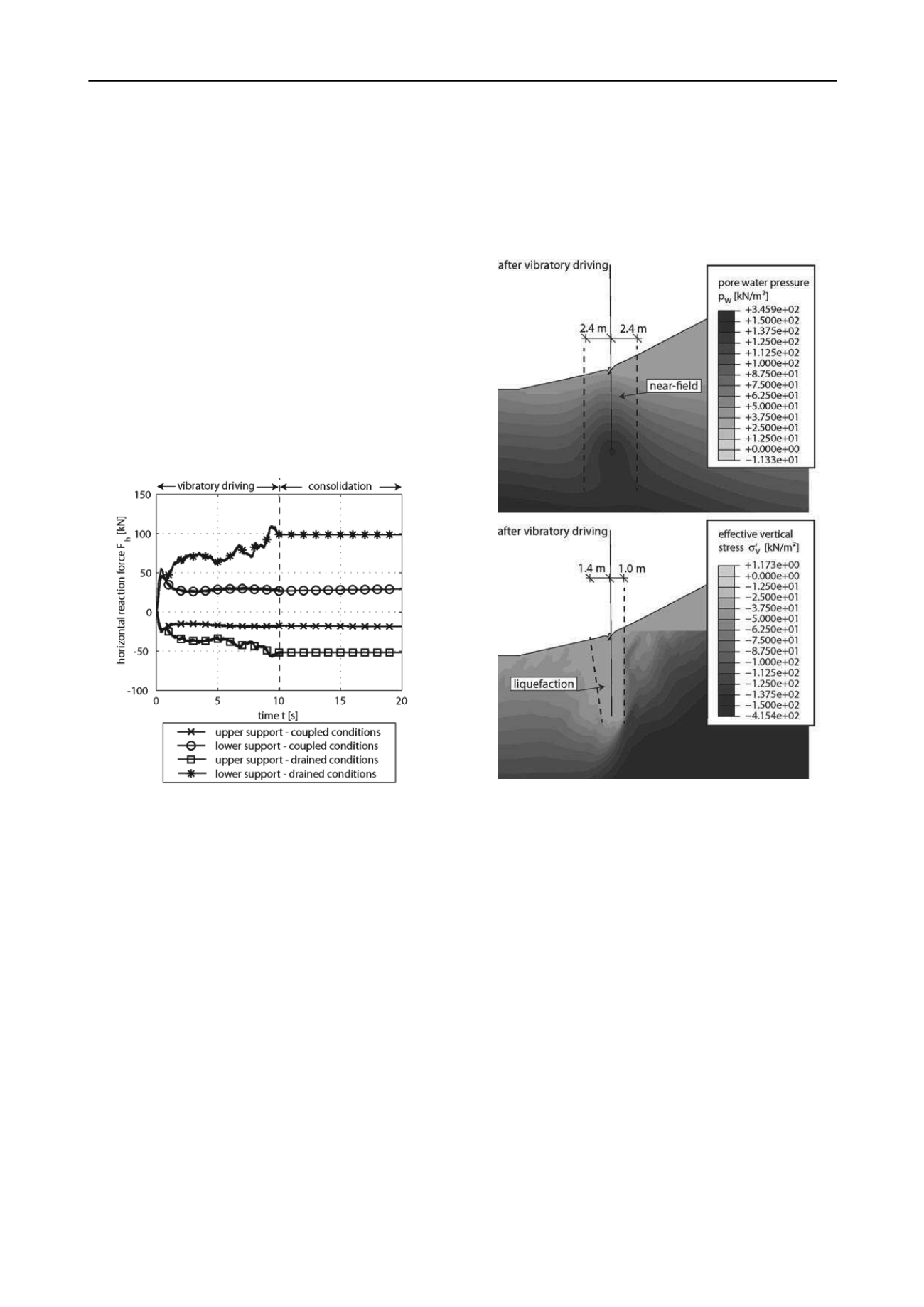
722
Proceedings of the 18
th
International Conference on Soil Mechanics and Geotechnical Engineering, Paris 2013
pore water pressure due to the layer of soil sliding into the near-
field and pushing against the pile and a simultaneously occuring
consolidation. Furthermore the horizontal effective stress state
is reduced in the near-field up to a locally limited soil
liquefaction arround the pile.
6 ACKNOWLEDGEMENTS
The presented investigations were carried out in the framework
of the research training group “Ports for Container Ships of
Future Generations” funded by the Deutsche Forschungsge-
meinschaft (DFG). The DFG is greatly acknowledged for
funding this work.
4.4
Distribution of pore water pressure and effective stress
The distribution of the pore water pressure and the effective
stress in the area of the embankment is shown in Figure 6 after
10 s of vibratory driving. A distinct increase of the pore water
pressure in an area of approx. 2.4 m arround the pile can be
observed. Excess pore water pressure of approx.
u
w
= 20 kN/m²
in the upper area of the near-field and
u
w
= 60 kN/m² at the pile
toe arise.
Regarding the effective vertical stress state a reduction of the
effective vertical stress state can be observed in the near-field.
In a distance of 1.0 m around the pile a temporary soil
liquefaction occurs. On the passive side of the
pile the area
becomes little larger at the surface area.
Figure 6. Distribution of pore water pressure and effective stresses in
the area of the embankment after 10 s of vibratory driving.
Figure 5. Evolution of horizontal reaction forces of the upper and
lower support, comparison of coupled (
k
f
= 1.0·10
-4
m/s) and fully
drained conditions of the soil, rigid pile driving guide.
7 REFERENCES
5 CONCLUSIONS
The numerical simulation of a case of damage, arised during the
installation process of a sheet pile wall in the area of an
embankment was presented. By use of the finite element
method the mechanical processes in the soil during the vibratory
driving can be explained e.g. a temporary and locally limited
soil liquefaction. The calculated deformations of the installed
sheet pile are in the range of the measurement data in case of a
coupled analysis. Thus the deformation mechanism can be
reproduced qualitatively correctly and in a quantitative
acceptable way. The results of a fully drained analysis show
great deviations to the measurement data. Regarding the
calculated reaction forces of a pile driving guide a fully drained
analysis provides also a different evolution of the reaction
forces with respect to time compared to a coupled analysis.
Darcy H. 1856.
Les fontaines publiques de la ville de Dijon
. Dalmont,
Paris.
Dassault Systèmes 2009. Analysis User-Manual. Abaqus 6.9.
Gudehus, G. 1996. A comprehensive constitutive equation for granular
materials. Soils and Foundations 36(1), 1-12.
Hamann T. and Grabe J. 2012a. Numerical investigations on vibratory
sheet piling in embankments. Proceedings of Baltic Piling Days
2012 in Tallinn (Estonia), electronically published.
Hamann T. and Grabe J. 2012b. Numerische Untersuchungen zur
Rammung von Profilen in Böschungen. Proceedings der 4. VDI-
Fachtagung Baudynamik 2012, VDI-Berichte 2160, 625-640.
Niemunis, A. and Herle, I. 1996. Hypoplastic model for cohesionless
soils with elastic strain range. Mechanics of cohesive-frictional
materials 2(4), 279-299.
In case of water saturated soil a consideration of
the development of excess pore water pressure
and the resulting effects seems to be of great importance for a
numerical simulation or a prediction of geotechnical problems
as presented.
Pichler T., Pucker T., Hamann T., Henke S. and Qiu G. 2012. High-
Performance Abaqus simulations in soil mechanics reloaded -
chances and frontiers. Proc. of International Simulia Community
Conference in Providense, Rhode Island/USA, pp. 237-266.
von Wolffersdorff, P.-A. 1996. A hypoplastic relation for granular
material with a predefined limit state surface. Mechanics of
cohesive-frictional materials 1, 251-271.


